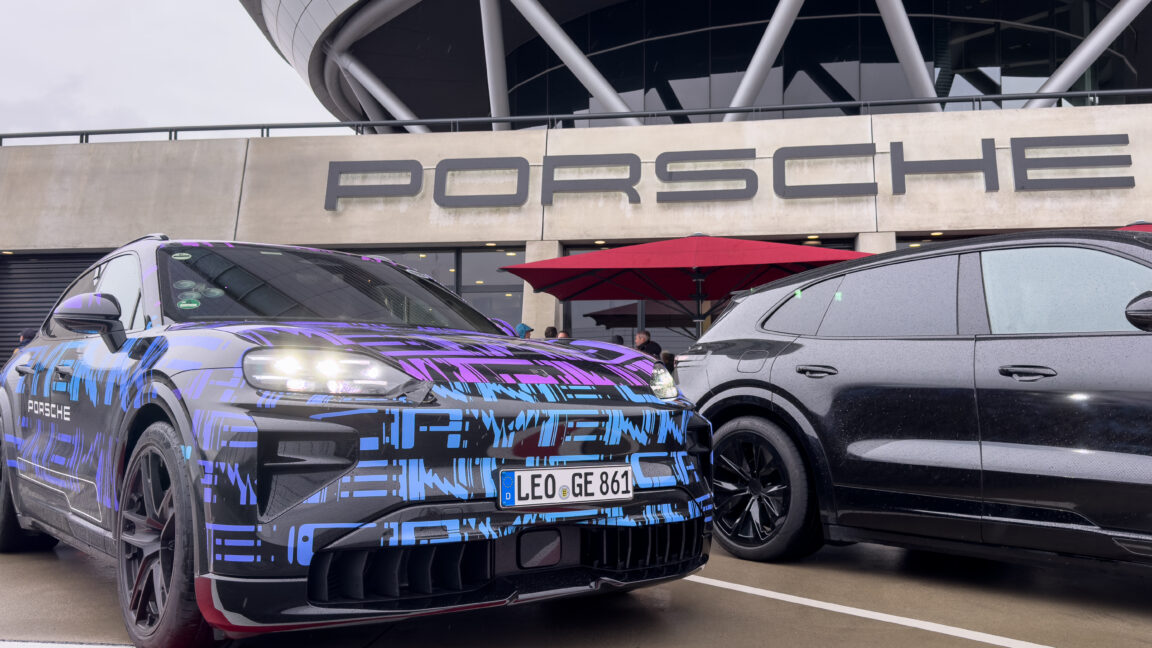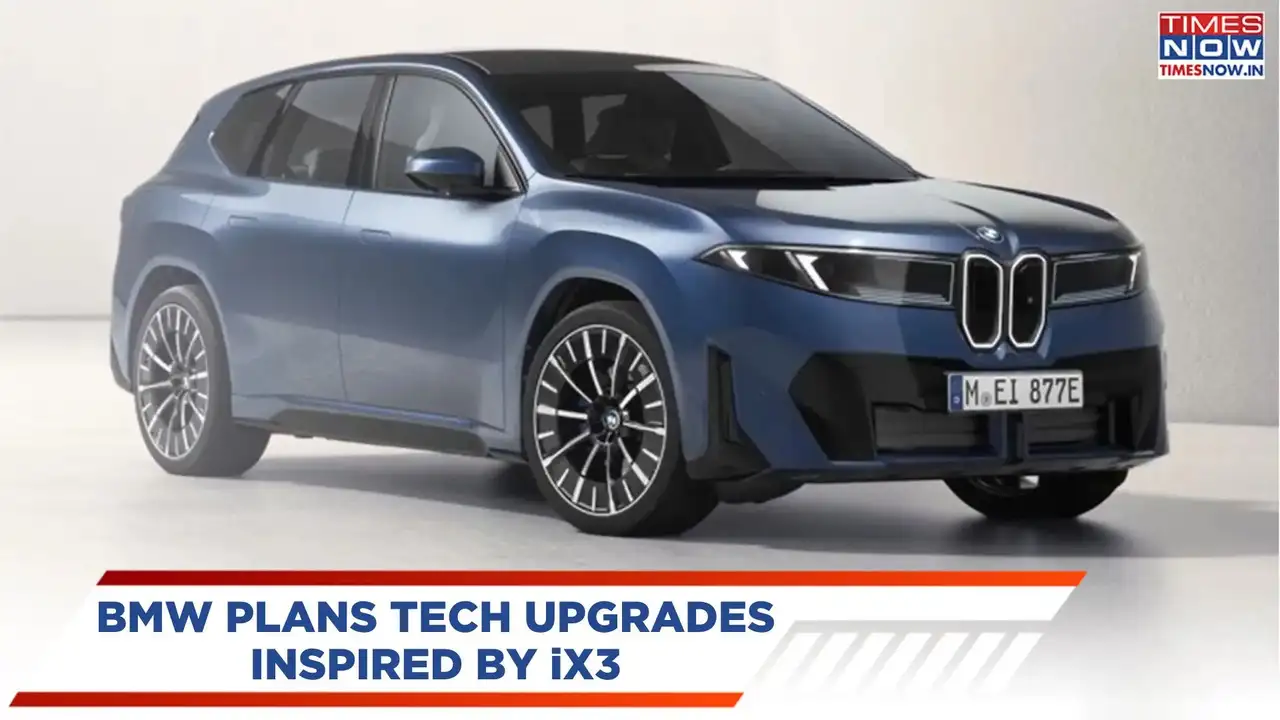
LEIPZIG, Germany—Porsche is synonymous with sports cars in which the engine lives behind the driver. From the company’s first open-top 356/1—which it let us drive a couple of years ago—to the latest stupendously clever 911 variants, these are the machines most of us associate with the Stuttgart-based brand. And indeed, the company has sold more than a million 911s since the model’s introduction in 1963. But here’s the bald truth: It’s the SUVs that keep the lights on. Without their profit, there would be no money to develop the next T-Hybrid or GT3. The first Cayenne was introduced just 23 years ago; since then, Porsche has sold more than 1.5 million of them. And the next one will be electric.
Of course, this won’t be Porsche’s first electric SUV. That honor goes to the electric Macan, which is probably becoming a more common sight on the streets in more well-heeled neighborhoods. Like the Macan, the Cayenne Electric is based on Volkswagen Group’s Premium Platform Electric, but this is no mere scaled-up Macan.
“It’s not just a product update; it’s a complete new chapter in the story,” said Sajjad Khan, a member of Porsche’s management board in charge of car IT.
Compared to the Macan, there’s an all-new battery pack design, not to mention more efficient and powerful electric motors. Inside, the cockpit is also new, with OLED screens for the main instrument panel and a curved infotainment display that will probably dominate the discussion.
In fact, Ars already got behind the wheel of the next Cayenne during a development drive in the US earlier this summer. But we can now tell you about the tech behind the camouflaged body panels.
OLED me tell you about my screens
Although the 14.25-inch digital main instrument display looks pretty similar to the one you’ll find in most modern Porsches, all of the hardware for the Cayenne Electric is new and now uses an OLED panel. The curved central 12.25-inch infotainment screen is also an OLED panel, which keeps customizable widgets on its lower third and allows for a variety of content on the upper portion, including Android Auto or Apple CarPlay. The UI has taken cues from iOS, but it retains a look and feel that’s consistent with other Porsches.
The bottom of the infotainment screen has some persistent icons for things like seat heaters, but there are at least dedicated physical controls for the climate temperature and fan speed, the demisters, and the volume control.
New battery
At the heart of the new Cayenne Electric is an all-new 113 kWh battery pack (108 kWh gross) that Porsche describes as “functionally integrated” into the car. Unlike previous PPE-based EVs (like the Macan or the Audi Q6) there’s no frame around the pack. Instead, it’s composed of six modules, each housed in its own protective case and bolted to the chassis.
The module cases provide the same kind of added stiffness as a battery frame might, but without devoting so much interior volume (and also mass) to the structure as opposed to the cells. Consequently, energy density is increased by around seven percent compared to the battery in the Taycan sedan.
Inside each module are four small packs, each comprising eight pouch cells connected in series. A new cooling system uses 15 percent less energy, and a new predictive thermal management system uses cloud data to condition the battery during driving and charging. (Porsche says the battery will still condition itself during a loss of connectivity but with less accuracy from the model.)
This all translates into greater efficiency. The pack is able to DC fast charge at up to 400 kW, going from 10 to 80 percent in as little as 16 minutes. Impressively, the curve actually slopes upward a little, only beginning to ramp down once the state of charge passes 55 percent. Even so, it will still accept 270 kW until hitting 70 percent SoC. For those looking for a quick plug-and-go option, Porsche told us you can expect to add 30 kWh in the first five minutes.
You’ll find a NACS port for DC charging on one side and a J1772 port for AC on the other. Porsche thinks many Cayenne Electric customers will opt for the 11 kW inductive charging pad at home instead of bothering with a plug. This uses Wi-Fi to detect the car’s proximity and will guide you onto the pad, with charging occurring seamlessly. (Unlike your consumer electronic experience, inductive charging for EVs is only a few percent less efficient than using a cable.)
The most powerful production Porsche yet
Less-powerful Cayenne Electrics are in the works, but the one Porsche was ready to talk about was the mighty Turbo, which will boast more torque and power output than any other regular-series production Porsche. The automaker is a little coy on the exact output, but expect nominal power to be more than 804 hp (600 kW). Not enough? The push-to-pass button on the steering wheel ups that to more than 938 hp (700 kW) for bursts of up to 10 seconds.
Still not enough? Engage launch control, which raises power to more than 1,072 hp (800 kW). Let me tell you, that feels brutal when you’re sitting in the passenger seat as the car hits 62 mph (100 km/h) in less than three seconds and carries on to 124 mph (200 km/h) in under eight seconds. This is a seriously quick SUV, despite a curb weight in excess of 5,500 lbs (2.5 tonnes).
A new rear drive unit helps make that happen. (Up front is a second drive unit we’ve seen in the Macan.) Based on lessons learned from the GT4 ePerformance (a technology test bed for a potential customer racing EV), the unit directly cools the stator with a non-conductive oil and benefits from some Formula E-derived tech (like silicon carbide inverters) that pushes the motor efficiency to 98 percent.
Regenerative braking performance is even more impressive than fast charging—this SUV will regen up to 600 kW, and the friction brakes won’t take over until well past 0.5 Gs of deceleration. Only around three percent of braking events will require the friction brakes to do their thing—in this case, they’re standard carbon ceramics that save weight compared to conventional iron rotors, which again translates to improved efficiency.
Sadly, you need to push the brake pedal to get all that regen. Deep in the heart of the company, key decision makers remain philosophically opposed to the concept of one-pedal driving, so the most lift-off regen you’ll experience will be around 0.15 Gs. I remain unconvinced that this is the correct decision; as a software-defined vehicle, it’s perfectly possible to have a one-pedal driving setting, and Porsche could offer this as an option for drivers to engage, like many other EVs out there.
While we might have had to test the 911 GTS’s rough-road ability this summer, the Cayenne is positively made for that kind of thing. There are drive modes for gravel/sand, ice, and rocks, and plenty of wheel articulation thanks to the absence of traditional antiroll bars. It’s capable of fording depths of at least a foot (0.35 m), and as you can see from some of the photos, it will happily drive along sloped banks at angles that make passengers look for the grab handles.
A new traction management system helps here, and its 5 ms response time makes it five times faster than the previous iteration.
The big SUV’s agility on the handling track was perhaps even more remarkable. It was actually nauseating at times, given the brutality with which it can accelerate, brake, and change direction. There’s up to 5 degrees of rear axle steering, with a higher speed threshold for turning opposite the front wheels, up to 62 mph (reducing the turning circle); above that speed, the rear wheels turn with the fronts to improve high-speed lane change stability.
The suspension combines air springs and hydraulic adaptive dampers, and like the Panamera we recently tested, comfort mode can enable an active ride comfort mode that counteracts weight transfer during cornering, accelerating, and braking to give passengers the smoothest ride possible.
More detailed specs will follow in time. As for pricing, expect it to be similar or slightly more than the current Cayenne pricing.



